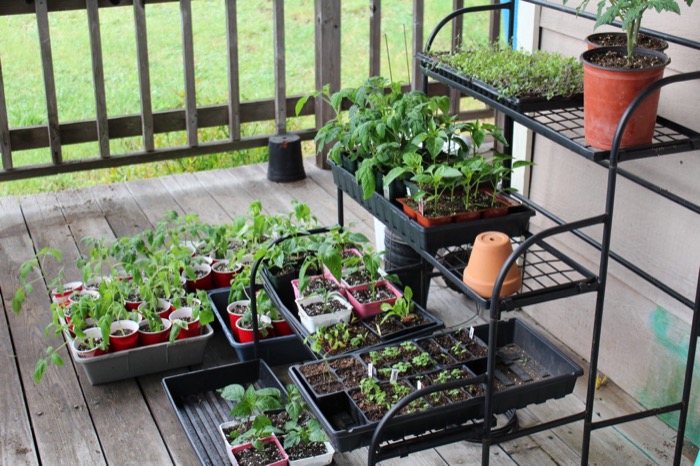March Garden Update Pt. 2
13 Apr 2016(March Garden Update Pt 1 here)
I’ve gotten really good at growing both tomatoes and peppers from seed. The biggest hassle is that they have to be started well ahead of when you plant them into the garden, which means getting the seeds into soil in February or even earlier, and then growing the plants indoors for a while under lights.
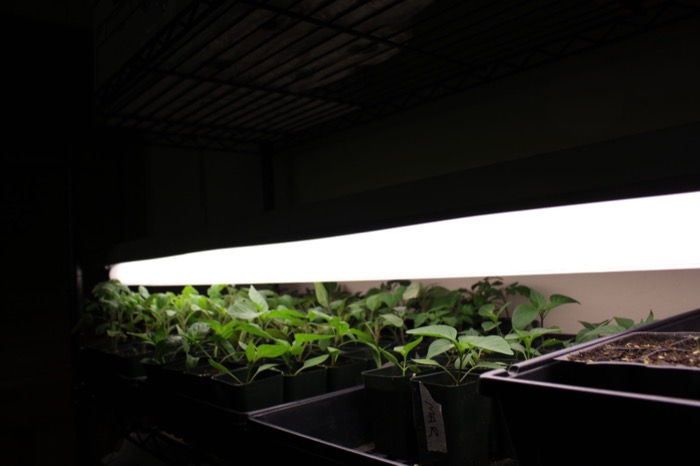
I always start some extra plants for both tomatoes and peppers as a hedge against disaster. I’ve had more than one year where rodents or late snow or early heat struck my seedlings and I was left having to fork over cash for store-grown tomato and pepper plants. This offends me. I try not to buy plants.
A couple of years ago when I had extra plants I started giving them away to the neighbors. And then I figured that it’s not that much more work to grow 60 plants than it is to grow 15, and my neighbors have all turned into tomato gardeners. I figure since I keep a rooster who starts shouting about how awesome he is at 5AM every day, it’s the least I can do.
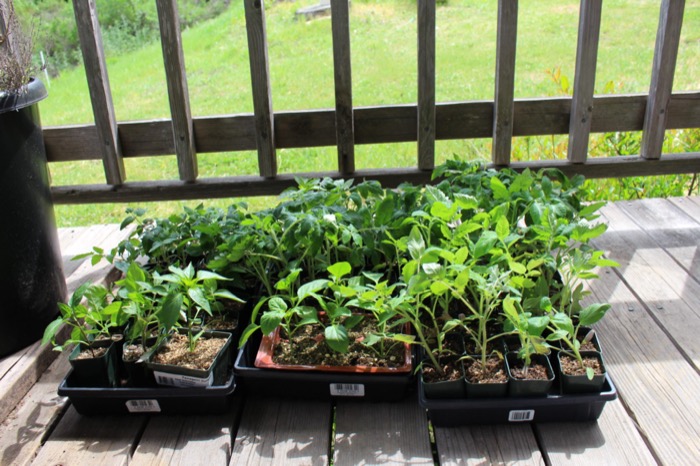
Over the last week I moved the tomatoes and peppers out from under the lights onto the porch and I’ve been busily repotting them — Solo cups for the giveaways, and gallon pots for me. The weather has been nice and from the forecast it looks like it won’t drop below 50 degrees overnight for the next week, at least. Neither tomatoes or peppers like the cold so if the temperature drops again I’ll bring them back inside.
Tomatoes
I usually grow two beds of tomatoes – one for the canners (eight plants) and one for the eaters (six plants). That’s usually more than enough tomatoes for us to eat and put away, with some extras to share.
Tomato varieties for this year:
- San Marzano, San Marzano Lungo: My standby canning tomato. I prefer the larger and more vigorous Lungo variety — fewer tomatoes to peel for the cans — but I have seeds for plain San Marzano that I’m trying to use up.
- Sungold: My standby cherry tomato, super productive. Tons of tiny sweet orange tomatoes. If I could only grow one tomato, it would be this one.
- Reisentraube: Red cherry tomatoes, and lots of them. Very reliable.
- Costoluto Genovese: A big lobed red tomato with really good flavor. One of the prettiest red tomatoes.
- Marmande: A big beefsteak tomato, one of the best tasting ones I grow, but not all that productive.
- Glacier: cold-tolerant, will bear small tomatoes early and well into winter. The tomatoes themselves are kind of boring but it’s nice to still have tomatoes after everything else is done.
- “stripe”: I don’t know what variety this actually is. I bought a red and orange striped tomato from the farmer’s market last year because it was so pretty, and I saved the seeds. I haven’t been able to figure out what variety it is no matter how much googling I do. If it’s a hybrid it likely won’t grow the same tomato I bought, and it could be something else altogether (but still a tomato.) We’ll see.
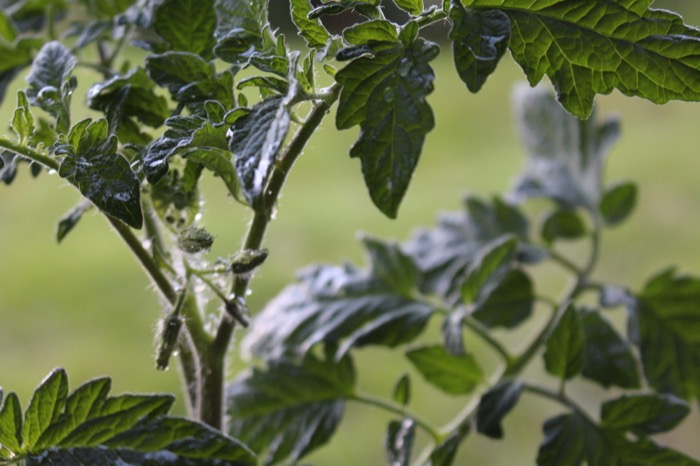
This year I’m also trying an experiment with dry-farmed tomatoes, and I have two early girl plants set aside for that purpose. I’m going to just stick them in the ground and see what happens. I expect this will be a short-lived adventure in the fastest method of killing a tomato plant, but I’ll save that adventure for another post.
Peppers
I grew a lot of peppers last year, and I’m growing a lot of peppers this year. This is another case where I had too much of something last year, so I figure I’ll grow more this year because, ¯\(ツ)/¯
I have 24 plants ready to go, although some of my seeds didn’t germinate that well. Pepper seeds get too old faster than I expect them to, and I’m left without pepper plants that I really wanted. I had to supplement with extras from the garden center.
Pepper varieties:
- Jalafuego: A dumb name for a good Jalapeno hybrid. Grows lots and lots of really big fat jalapenos. I’m almost definitely growing too many of these this year because I’m still working through the frozen ones from two years ago, but Jalapenos are easily give-away-able.
- Tiburon: A poblano hybrid. Poblanos are my favourite peppers, and we eat a lot of chile rellenos in the summer when they’re ready. This variety grows extra large peppers that are more abundant and wider at the stem than normal poblanos, so they’re better for stuffing.
- Pimiento di Padron: super popular foodie frying peppers. I stopped growing these for a while because if you don’t pick them tiny they turn super hot. I actually prefer a frying pepper called Melrose but I’m using up the seeds.
- Marconi: The standard italian red and yellow sweet pepper you get in the jars of roasted peppers. I grew these a few years back and they didn’t bear very well, but I have some enormous number of seeds so I’ll try again.
- Sweet Red Bell Peppers: My usual spanish mammoth peppers did not germinate at all so I bought a six-pack of completely ordinary red bell peppers to replace them this year.
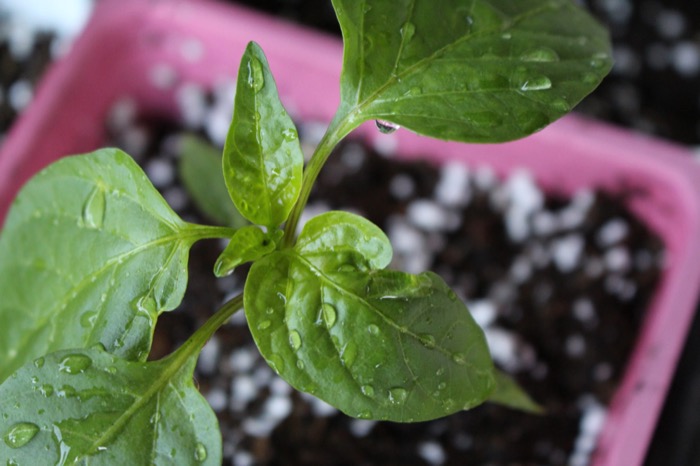
You may notice that the Japalenos are the hottest chiles I grow. There are no Habaneros or Scotch Bonnets or Bhut Jolokias here. This is mostly because I just can’t take super hot chiles (I recognize and accept this weakness). If I change my mind and want a super hot chile there are lots of them in the farmer’s markets. I may plant too much of a lot of things, but I’m hesitant to give over garden space to something I can’t actually eat.
This is always the busiest part of the year for me for gardening, and the time of the year I feel like I’m repotting tomatoes and digging up garden beds in my dreams. But it’s really gratifying to see trays and trays of happy seedlings out on the porch, and I know if I keep plugging away at it the work will get done. Only a couple more weeks now and everything will be planted in the garden and growing, and I can take a little rest before harvesting season.
